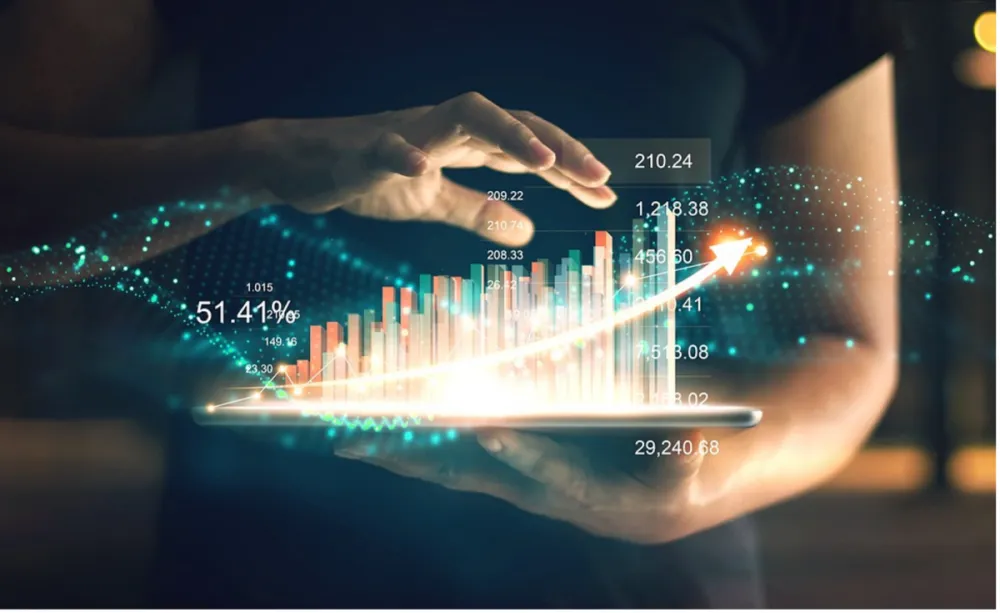According to a famous saying, “A picture is worth a thousand words“, which means it is easy to describe something pictorially than to elaborate it with words. But a picture alone cannot describe the whole text. You need to understand the source of data, its context, why and how it is collected. Then presenting that potential synergy containing visuals and text makes it easy to comprehend for others.
Thousands of terabytes of data are present around us that need to be analyzed, and we need to present its results in a pictorial form to make them easy to understand for us and others.
In this article, we will discuss Data Visualization and its benefits. Why it is essential, and what is the ultimate goal of visualizing data. If you are willing to pursue your career as a Data Scientist, Business Intelligence Analyst, Data Engineer, or Data Analyst, make you read this article till the very end as it will prove valuable to polish your skills.
What is Data Visualization?
Data visualization is the process of graphically presenting data and information in the form of graphs, charts, maps, and other data visualization tools. Such tools provide an easy way to comprehend and notice the trends and tendencies in data. They also help accelerate the research and data analysis by providing an interactive way to present complex data in the form of aesthetically attractive features.
Types of Data Visualization
Data Visualization is divided into six different types, but more types are also expected to add up in them in the near future. These types are described below:
These types of conceptions depict ordered groups inside a larger group. In easy words, the primary perception for these visualizations is the groups can be demonstrated if the flow of the clusters starts from a single point. e.g. Ring Charts, Tree Diagrams, TreeMaps, and Circular Packing.
- Multidimensional
This type of visualization contains multiple dimensions. Using concurrent layers, we can create 3-Dimensional visualizations. It helps the user to present key findings and filter out non-useful data. Examples of Multidimensional Data Visualization include Scatter plots, Parallel coordinate blocks, and stacked bar graphs.
- Temporal
Temporal visualizations present data that is one-dimensional and linear. They are presented through lines with a typical start and endpoint and can overlap during the representation. Examples of temporal data visualization are line graphs, pie charts, scatter plots, polar diagrams, time series, etc.
- Geospatial
Such visualizations are related to the current physical and real-life location by pointing that out over maps. The motivation behind geospatial maps is to present a holistic view of the findings to be inclusive. Cartogram. Heat Map, Flow Map and Choropleth Maps are examples of geospatial data visualization.
- Network
Network visualizations prove to be valuable in connecting one dataset to another. They present the way how one dataset is related to other data set inside a network. e.g. Word Cloud, Node link diagrams, Matrix charts, and Alluvial Diagrams.
- Miscellaneous
Apart from the types mentioned above, there are certainly other types classified as miscellaneous instead of forming their groups. Kagi charts and open-high-low-close charts fall under this category.
Data Visualization Benefits
The list of data visualization benefits is a long one, from better decision-making to quick and convenient trend analysis, data visualization has a lot to offer. By visualizing tons of data in an appealing form, it helps to go through chunks of data in a fraction of time.
Large files containing large volumes of data make it difficult to present data and identify trends in them. Data visualization is the tool that lets us draw important information from these files without manually needing to go through tons of data.
A lot of software are available that help visualize data in the form of patterns and graphs. They help to convert facts and figures into detailed patterns known as data visualization. Let’s look at the benefits of data visualization in detail below:
1. Better Decision making
Data visualization provides easy-to-understand visuals that help to analyze data quickly and accurately. This leads to a better decision-making approach in no time. Presenting your finding in the form of visuals make it easy to comprehend. It helps others to take insights quickly and decide what needs to be done.
It also becomes easy to communicate using visuals as humans tend to understand things pictorially than reading long reports containing facts and figures. Such representations also help to identify how dependent variables change with the change in independent variables. There are many ways in which data visualization helps to make better decisions within the time that are listed below:
- Accuracy
In business intelligence, it is necessary to make rational and timely decisions about the presented data, but reviewing a large amount of raw data for this purpose is not a practical approach. The decision thus made is more biased and assumption-based. Data visualization ensures the accuracy of data.
Psychologists fix the issue of biased decisions by referring to a term called Heuristics. They are described as mental shortcuts that help you make decisions quickly and efficiently. Data visualization clarifies the information being presented and thus reduces the gaps for assumptions and personal biases, leading to accurate decisions.
- Speed
Visualizing data helps decision-makers to just look at the data and understand what is being presented. It leads them to a solid decision easily and quickly. Presenting data pictorially reduces the response time and helps in the identification of issues in very little time. Simple pie charts or bar graphs can prove quite valuable in presenting data in the form of easy-to-understand insights.
Such an approach is excellent in proactive departments such as government, bureaucracy, and healthcare. Such fields require critical decision-making in less time because if they wait too long for the conclusion, there is the chance that they might miss an opportunity causing exponential loss to the organization.
- Encouraging alliance in decision making
Data visualization helps create data into a more usable form by providing people with the tools that help them develop informed opinions and encourage them to participate in the decision-making process. This approach of data visualization is convenient where business leaders are faced with such impactful decisions.
Business leaders must be equipped with excellent decision-making skills. By integrating data visualization with the decision-making procedure, we can enhance collaboration and communication and advance speed and reduce imprecisions to a large extent.
- Clear communication in decision making
It is a good practice to communicate your idea to others to enhance decision-making. After deciding on a plan, you must communicate with other people who ought to carry out further steps.
In this way, data visualization simplifies communication. Visualizations describe the meaning of data more than the text alone can do. They help people understand facts and figures in a better way. If your data is appropriately visualized, it will help the audience comprehend quickly and then utilize that in decision making.
2. Trend Analysis with time
Trend analysis in data visualization aims to find a trend in data by analyzing the events and predicting future events based on that analysis. It also proves to be very beneficial as it helps us see the trends visually and keep track of our performance over time.
It helps us identify the stage where we were at a given time and where we have come so far. It helps in identifying our shortcomings and the point where we need to apply an effort.
Following are some of the tools that help us analyze data over a period to find any visible trends and spots.
- Area Graph
- Bubble Chart
- Line Graph
- Histogram
- Spiral Plot
- Steam Graph
Certain practices need to be applied to visualize data over trends for analysis. They are described as follows:
- Always use vertical bar charts to present data clearly
- Sort the period in the table in ascending order
- Apply color schemes to the bars to make them visually appealing for the audience.
By following these practices, you can quickly analyze data and find trends over time.
3. Correlation
In the fields like Business Intelligence, it is crucial to find a correlation between the association of independent variables. Through this, we can easily make important decisions in business. Correlation is one of the most valuable tools in statistics. It helps to see the relationships among independent variables. Through data visualization, it becomes handy to identify the association via infographics and other visuals.
4. Storytelling
The word storytelling refers to explaining a story to make it clear to the target audience. Pictures, photos, and other visuals help in better storytelling depicting the exact meaning of what you want to convey. It also enables you to create your own story digitally to tell the story effectively.
The importance of data visualization in storytelling can be confirmed from the survey conducted in the Finance industry in 2018. The facts stated that 81% of the respondents found data visualization effective in storytelling. This survey was conducted among 900 finance professionals comprising 450 CFOSs and 900 finance professionals. This implies the significance of data visualization and depicts its value in the Finance industry today and in the future. Data visualization helps business leaders to be proactive and provides timely support in decision-making. In this way, they can quickly tell a story and take decisions in no time.
For further information regarding Data Visualization and Storytelling, stay tuned to our future blogs.
5. Analyzing Market Trends
Visualization also helps in analyzing market trends in society. Through this, we can quickly identify where is the loss occurred and at what point our investment resulted in profiting the organization. Without visuals such as charts and graphs, it would be very tedious to look into piles of data in the form of numbers. Using this approach, we can quickly note the things in our favor and the things we have to stay away from.
6. Better Data Analysis
Data analysis is the process of analyzing raw data in the form of facts and figures to valuable information. Looking at these facts and figures, and tables individually can be a very tedious task. Data visualization helps analyze data in a better way by visualizing it in the forms of charts, graphs, histograms, and many more tools. This makes data analysis easy because we can easily identify significant patterns in the data set.
7. Virtual Reality Visualization
Virtual reality data visualizations refer to the 3D projects that are computer generate and highly collaborative. The concept of VR is not new, but the concept of visualizing such a large amount of data and presenting them in collaboration with Virtual Reality is a new domain in Data Science.
Photo by RODNAE Productions from Pexels
In addition to the presentation of two-dimensional images, visualizations used in VR also help recognize patterns and retentions quite efficiently. Following are some of the technologies generated by combing the concept of data visualization and Virtual Reality:
- Google Chrome Experiments
- Google Labs- Brexit
- Tour of 21 years of Nasdaq- By Wall Street Journal
- Solitary Confinement- The Guardian
- Titans of Space – Oculus Rift DK2
- Blue Whale Experience – Fusion
Highly Recommended Next Articles
-
The Role of Data Analytics at The Senior Management Level

From small and medium-sized businesses to Fortune 500 conglomerates, the success of a modern business is now increasingly tied to how the company implements its data infrastructure and data-based decision-making. According
-
The Decision-Making Model Explained (In Plain Terms)

Any form of the systematic decision-making process is better enhanced with data. But making sense of big data or even small data analysis when venturing into a decision-making process might
-
13 Reasons Why Data Is Important in Decision Making

Data is important in decision making process, and that is the new golden rule in the business world. Businesses are always trying to find the balance of cutting costs while
What is the Goal of Data Visualization?
Data visualization refers to the visual representation of data. The ultimate goal of data visualization is to present information to be conveyed easily to the target audience in a more artistic, elegant, and effective way. We can achieve this goal only if the data given to us can be easily comprehended by our brain and pleasing our eyes.
In recent times, the goal of data visualization has advanced from simple graphs and charts to visually pleasing dashboards that keep track of metrics and all related stuff. But there is a challenge associated with it. As it fails to meet its ultimate goals due to lack of communication and unwanted details
Another goal of data visualization is to support decisions making by using information that is appropriately presented. If the data is elegantly designed and visualized, it will help in proper reasoning and lead to successful decision-making because visualized data is easy to comprehend.
Takeaway
In this article, we have taken a brief introduction to data visualization, how to visualize data and its benefits. It is to be noted that visualizing data is an efficient approach in decision making by quickly identifying trends and patterns in the data. Presenting boring facts and figures in appealing and eye-catching visuals such as charts and graphs proves to every handy.
Moreover, it is also helpful in different industries such as healthcare, finance, and business. By analyzing trends in the market, we can easily find out the points at which an effort is needed and the points we have to stay away from. If you are going to pursue your career in data visualization or are willing to visualize data, make sure to take notes from this article.

